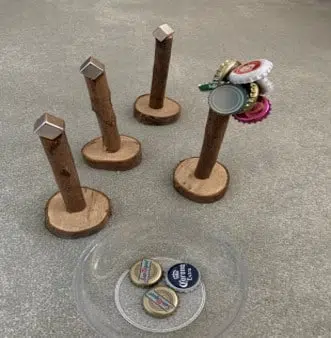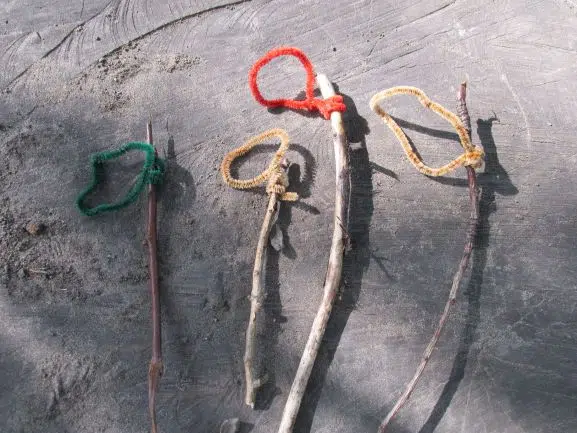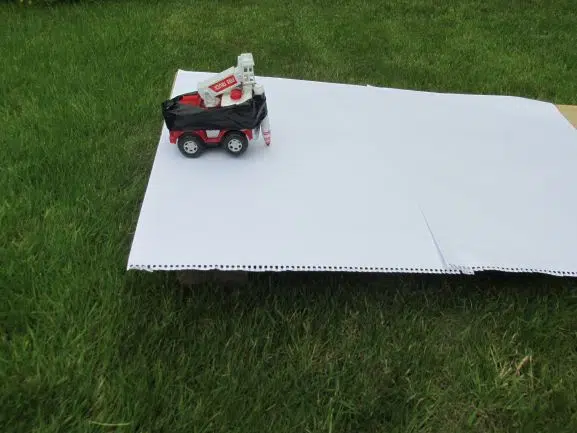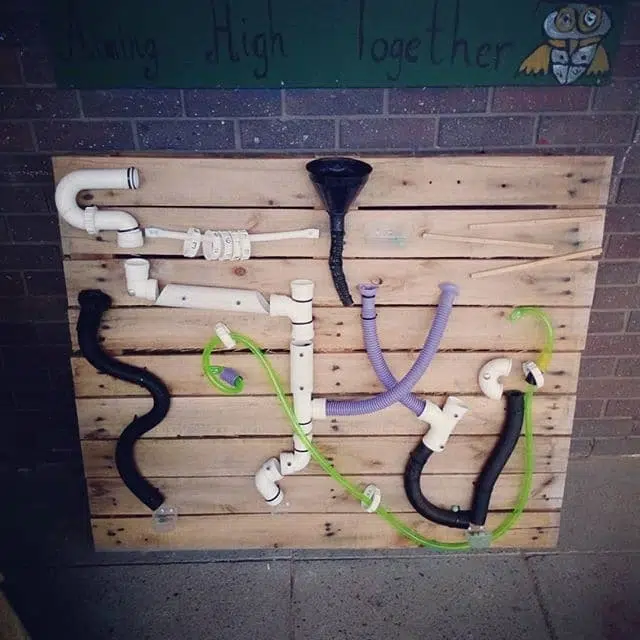Have you got children that will happily run around chasing leaves in the wind for hours at a time?
Or maybe you have a kid that can’t stop throwing pretty much anything that comes into their path?
It’s highly likely that these kids are demonstrating a trajectory schema. This means that they are interested in moving objects.
A trajectory schema is one of the most common that you will come across. It is one that often needs a lot of support to help the children express the schema in a safe way.
No one wants to be hit on the head when kids throw balls or toy cars! (for example)
But if you learn how to first identify, and then support this schema, then children will learn more deeply and also safely.
In this post, I will look at exactly what a trajectory schema is, why you want to support it through schematic play, and then a whole host of learning experiences that will help children who demonstrate it.

What Is A Schema?
A schema is a repeated pattern of behavior that you observe in a child.
Children construct models of reality in their minds. Schemas are a way of them testing these models on the world around them.
The theory of schemas has been a part of child development psychology for the last 100 years.
Schemas give us clues about how they view the world and how children learn.
For example, a child that enjoys lying on their back, looking at things through their legs, or putting their head flat on the floor when playing with toy cars is probably demonstrating an orientation schema.
Likewise, a child that regularly creates long lines of resources such as stones and sticks, or that likes putting toy figures in a line, is probably demonstrating a positioning schema.
There are many known schemas, but most commonly talked about are the following nine:
Enclosing
Orientation
Trajectory
Positioning
What Is A Trajectory Schema?
Children who demonstrate a trajectory schema enjoy moving, watching movement, or making movements happen.
For example, they love to throw objects and see where they land.
They have an interest in all things that are moving.
They like to move objects by throwing or rolling.
They are interested in interacting with objects that are moving by themselves, such as blowing leaves.
Why Should We Support Schemas?
Schemas are not just an abstract concept. They are a fantastic natural force that can be harnessed for many benefits.
By understanding and supporting schema play, you tap into children’s interests. You are working alongside nature to get the best possible results. (Source)
Supporting schematic play particularly helps the following:
- Schemas help children test reality
- They help children make good progress
- They help them think and flourish
- They deepen and intensify play experiences
26 Trajectory Schema Activities
1. Rope Swings
These are one of the ultimate outdoor learning experiences, and children get a huge amount out of rope swings.
They are easy to set up. Pretty much all you need is some kind of rope and a secure branch, post, or pillar to suspend them from.
Children enjoy and play schemas by:
- Swinging themselves
- Pushing others
- Even just swinging the empty rope
2. Throwing Bottle Tops At A Magnet
This is a really fun DIY project that supports trajectory schema.
What you need is a strong magnet, a log slice, a wooden stick, a drill, and some super glue.
Drill a hole in the log slice and super glue the stick into the hole. Superglue the magnet to the top of the stick. It should look a bit like this:

You now have created your magnet base for the game.
All you need now are some bottle tops. The idea is to stand a bit back from the magnet base, and throw a bottle top at it. Get it close enough to the magnet and it will stick!
You can play this as either a one-player or multi-player game.
3. Throwing Leaves Into The Air
Windy days offer lots of opportunities to support trajectory schemas.
Many children will be fascinated by watching trees swaying in the breeze.
A classic trajectory schema activity is anything to do with leaves. Children can play schema by:
- Chasing leaves as they are blown across the floor
- Gathering up bundles of leaves and throw them into the air
- Throwing leaves and allowing them to rain back over their heads
4. Hammocks
Hammocks are fantastic for both orientation schemas and trajectory schemas.
For orientation, children are viewing the world in a constantly moving format.
For trajectory schema, you can do all sorts of things with hammocks. Children enjoy pushing others and watching them swing backward and forwards.
I have also seen many children push toys such as a bear in a hammock. Also, they like to swing in them themselves, or swing with others as well.
Hammocks are reasonably easy to set up. If you are blessed with some trees then just find 2 about 2 yards apart and suspend the hammock from them. I have also seen hammocks in urban settings, attached to fences or metal posts.
You can buy hammocks relatively cheaply, or potentially make them from strong material and thin ropes.

5. Playing In Puddles
Puddles offer all kinds of trajectory schema experiences. Kids can play schemas by:
- Jumping in the puddle and watch the splashes
- Brushing the water out of the puddle, making rivulets and initiating the flow of water
- Stirring the puddle with sticks or spoons
6. Experimenting In The Mud Kitchen
Mud kitchens offer lots of opportunities to explore moving objects and schematic play. Children can investigate:
- Pouring water between containers
- Stirring potions with water, bark, flowers, and other substances – watching them all swirl around
- Pouring water over objects and seeing the effects
7. Throwing Natural Objects Into A Bucket
This is a fun way of harnessing this instinct to throw.
All you need is some buckets and a collection of objects to throw into them. Some good things will include:
- Conkers
- Small beans
- Bean bags
8. Tire Swings
Tire swings are another fantastic outdoor resource that promotes schematic play and learning in all sorts of ways.
You can easily create a tire swing by suspending a tire from a rope and attaching it to a tree, pillar, or horizontal post.
Children can enjoy trajectory schema play by:
- Swinging themselves
- Swinging others
- Pushing toys

9. Jumping Off Pallets
This is a classic forest school activity. Not only is it good for trajectory schemas, but it has benefits for risky play also.
The classic way to do it is to have a stack of about 10 pallets. Pallets are normally easy to find for free at local shops or factories.
Have some way that the children can climb onto the pallet stack. This could be a small ladder or a few crates stacked on a staircase.
The kids then jump off the pallet stack! Super simple but also children learn trajectory schema while having fun doing it!
10. Slinkys
Remember these!
Children with a trajectory schema will be fascinated by the way slinkys appear to move completely by themselves.
They will experiment with them moving down steps.
11. Jumping Off Constructions
Some children seem to enjoy building constructions outside for the simple purpose of climbing up them and jumping off!
This is a trajectory schema in action that also helps build gross motor skills.
To facilitate this trajectory play schema, pretty much all you need to supply is lots of big outdoor loose parts. These can include some of the following:
- Crates
- Planks
- Wooden boxes
- Tires

Children can create obstacle courses and towers out of these, and jump off them if they so wish!
12. Trampolines
There are lots of benefits of trampolines. They strengthen the legs and core muscles, help with spatial awareness, and develop gross motor skills.
But also they are great for trajectory schemas.
Children love to bounce by themselves, with others, and also often with toys. They enjoy watching a bear bouncing just as much as bouncing themselves.
13. Sponges And Water With Play Trays
This can be a very simple trajectory schema activity for younger children, but I have also done it in a more advanced form for children later on.
In its most simple form, lean a big play tray up against a wall.
Have buckets of water and sponges. The kids dip the sponges in water and fling them at the play tray!
To make this trickier, I have used this game to teach both math and phonics.
For example, it can be a number recognition game.
Write some numerals on the play tray in chalk. Then the children throw sponges at a particular number.
You can direct the children by saying things like, ‘can you hit 7?’ You could go further and ask things like:
- Hit the number that is 3 add 2
- Hit the number that is one more than 8
This game can also be done to teach phonics. You could write some of the following on the play tray:
- Letters
- Words
- Simple phrases
14. Bean Bag Game With Hoops
This is a nice and simple trajectory play schema.
Have some hoops spread out on the ground. The kids throw beanbags into the different hoops.
You could enhance the game by adding features to each hoop.
You could add:
- numbers
- Letters
- pictures of, for example, animals
And ask the children to aim at a particular hoop.
15. Scarves And Ribbons
There are several resources that are easier than balls to learn to throw and catch with.
A really good one is using scarves and ribbons.
You can use them to play catch, either with yourself or with others.
Scarves work brilliantly because they float down really slowly. Some children like to use them like leaves, gathering up a load, and throwing them up into the air.
Children also like to run around with scarves and ribbons billowing out in the wind.
16. Paper Planes
Making paper planes is a fantastic trajectory schema activity to try if you have lots of space outdoors to fly them safely.
Children experiment with:
- Throwing them into or away from the wind
- Dropping them from a height
- Experimenting with different sizes, designs, and types of paper
17. Bowling
There are many bowling games you can try. These include:
- Mini 10-pin bowling sets
- Boules
- Skittles
18. Catching And Chasing Bubbles
This is one of the most exciting trajectory schema activities on this whole list!
Pretty much all children have an interest in bubbles, and they are particularly fascinating for those with a trajectory schema.
Some simple ideas include:
- Having a bubble machine that releases bubbles into the air for the children to chase and pop
- Support the children to blow their own bubbles from little pots or use big bubble ones
- Create natural bubble wands using sticks and pipe cleaners. Get a stick, and twist a pipecleaner into a circle and attach it by twisting it to the top of the stick. Dip these in a bubble mixture and start blowing!
The natural bubble wands look something like this:

19. Throwing And Catching Balloons
Balloons are another resource to play schema and can be simpler than balls when learning how to throw and catch.
Children can throw and catch them in teams.
A game they really enjoy is a team of four must keep a balloon from hitting the floor by helping each other to hit it into the air.
20. Yo-Yos
Although quite challenging for many young children, yoyos are something an adult could demonstrate to support children fascinated by trajectory schema and creating movement.
21. Frisbee
Frisbees are great for trajectory play schema if you have enough space and can use them well away from other kids playing with other equipment.
They are not the easiest control for young children, so just make sure to set guidelines before they are used.
22. Kites
Kites are fascinating for many reasons including trajectory schemas.
The very simplest way to make a kite is to tape a piece of paper to a length of string. Kites like this will work well on windy days, with kids running about with the kite billowing out behind them.
23. Using Ramps
Ramps are good for helping children experiment with gravity and speed.
You can test lots of things on ramps including some of these:
- Roll balls down it
- Have races between toy cars
- Experiment with different ramp gradients
- Pour water down ramps
I’ve even tried these trucks with pens on, that write as they go down the ramp! Here’s a picture of one in action:

24. Hair Rollers
It is amazing the fascination that hair rollers have for some children. You can use them to roll down ramps, or roll in malleable substances such as play Doh.
25. Rollable Items
Having a selection of rollable items placed around your learning environment supports children that have a fascination with rolling.
Some items to have available include:
- Rolling pins
- Balls
- Water wheels and sand wheels
- Cylindrical building blocks
26. Guttering And Pipes
Any equipment that can support children in manipulating the flow of water is fantastic for trajectory schemas.
You can have a selection of gutters and pipes.
I like to use the stands that you can get to hold the gutters. Children can then create their own pathway of gutters, and pour balls or water down them.
I have also been to schools where they have gutters or pipes secured 2 fences. Often they can be rotated on the fence to make different pathways.
Here is a picture of ‘ball wall’ that we had at a school I taught at:

There was some serious DIY that went into this! But it is basically a pallet attached to a wall, and some tubes, all of which are moveable and rotate on a hinge.
The kids used to enjoy creating pathways for balls to move down – great for problem-solving and critical thinking!
Final Thoughts On Trajectory Schemas
Trajectory schemas are one of the first schemas you will witness in a child. Think about a baby dropping a toy repeatedly out of its cot!
Also, they are one of the most common.
By harnessing this schema, you help children demonstrate their interests in a safer way.
Good luck identifying and supporting trajectory schemas!
